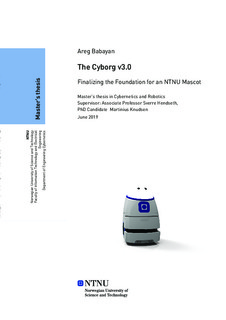The Cyborg v3.0: Finalizing the Foundation for an NTNU Mascot
Master thesis
Permanent lenke
http://hdl.handle.net/11250/2625657Utgivelsesdato
2019Metadata
Vis full innførselSamlinger
Sammendrag
NTNU Cyborg-prosjektet har som målsetning å muliggjøre kommunikasjonmellom levende nerveceller og en robot, og dermed utvikle en cyborg. Denneoppgaven presenterer arbeid utført på en av prosjektets roboter, The Cyborg,som på sikt skal transformeres til en cyborg og maskot for universitetet.Fokuset er på å gjøre the Cyborgen klar for demonstrasjon. Kroppen og LEDdomen til Cyborgen må ferdigstilles og integreres, og resterende Cyborg ROSmoduler integreres.Motivasjon for en enklere programvarestruktur og en evaluering av Cy-borgen presenteres. De nåværende Cyborg ROS modulene blir delvis reim-plementert, med formål om å redusere kompleksiteten. En adferdsmodulblir designed og implementert, modulen gjør flitting brukte utgangsmodulertilgjengelig via et felles grensesnitt, og lar en forhåndsinstille adferder somkan bli brukt av andre moduler eller som tilstander i tilstandsmaskinen.Cyborg start boksen blir oppgradert for å gjøre det mulig å stoppe og startenye moduser, og navnet blir endret for å passe den nye funksjonaliteten bedre.Som en videreføring av forfatterens spesialiseringsprosjekt, blir kontrollerentil LED domen realisert, og tilhørende programvare ferdigstilt. Forfatterenhar assistert grupper fra Eksperter i Team med deres arbeid på kroppen,LED domen og programvare relatert til Cyborgen, deres bidrag har vist segå være til stor nytte for prosjektet. Kroppen til Cyborgen er ferdigstilt, ogLED domen integrert i Cyborgen.Det blir argumentert for hvorfor en omstrukturering av programvaren variiidet rette valget, og en liste over foreslåtte fremtidige oppgaver presenteres. Påslutten av denne oppgaven er tilfresstiller Cyborgen de angitte spesifikasjonene,og den er klar for demonstrasjon. The NTNU Cyborg project aims to enable communication between livingnerve tissue and a robot, thereby creating a cyborg. This thesis presents workdone on one of the projects robots, The Cyborg, aimed at being transformedinto a cyborg and university mascot. The focus is on making the Cyborgready for demonstration. The Cyborg body and LED dome needs to befinished and integrated, and all current Cyborg ROS modules integrated.Motivation for a simpler software structure and an evaluation of the Cyborgis presented. The current Cyborg ROS modules are partly reimplemented,with the aim of reducing complexity. A behavior module is also designed andimplemented. The module makes commonly used output modules availablethrough a single interface, while providing a way to configure simple behavioralpresets that can be used by other modules or as states for the Cyborg statemachine. The Cyborg Start-up Box is upgraded, adding the ability toterminate and select new modes of operation on the Cyborg, the name ischanged to Mode Selector in order to better fit the new function.As a continuation of the authors specialization project, the controller forthe LED dome is realized and the corresponding software finished. The authorhas assisted Experts in Team groups with their work on the Cyborg body,LED dome, and software, their contribution has proven greatly beneficial forthe project. The Cyborg body is finished and the LED dome integrated intothe Cyborg.An argument is made for why the restructured software was the rightichoice, and a list of proposed future tasks is presented. At the end ofthis thesis the Cyborg satisfies the presented specifications and is ready fordemonstration.
